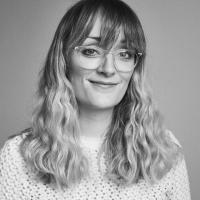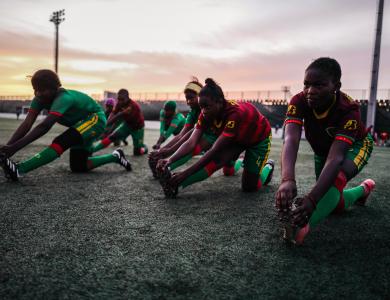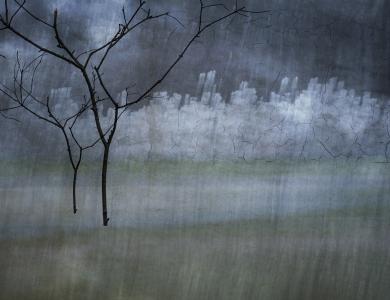With the deadline for the Student competition later this month (make sure you get your entries in before 30th November!) we put this year's judge Aesthetica Magazine Assistant Editor Kate Simpson under the spotlight.
Kate joined Aesthetica Magazine in 2016 and, in addition to writing for and editing the magazine, has also worked on number of other annual publications and competitions including the internationally renowned Aesthetica Art Prize and BAFTA-Qualifying Short Film Festival. Kate has worked with a number of high-profile organisations such as Apple and Magnum Photos. She has also worked alongside some of the world’s largest photography fairs including PHOTOFAIRS, Rencontres d’Arles, Circulation(s) and Unseen Amsterdam, as well as global institutions such as MoMA, New York; Foam Amsterdam; Centre Pompidou, Paris; Tate, London and MCA Australia, amongst others. She has also programmed for large-scale lecture series and cultural events, including the Aesthetica Future Now Symposium. She has spoken at numerous events about publishing, journalism and the effects of the digital age on contemporary culture, including Frieze London and Sotheby's Arts Publishers Fair.
The first brief for the Student competition is Building a Better Future. What will you be looking for in this year’s entries?
I’m thrilled to be judging a competition with such an important brief. In the 2018 book The Human Planet: How We Created the Anthropocene, authors Simon L. Lewis and Mark A. Maslin state: “If you compressed the whole of earth’s unimaginably long history into a single day, the first humans that look like us would appear at less than four seconds to midnight.” What have we done with those four seconds, and what will happen after the strike on the hour?
2020 has teetered between grief, frustration and destruction. From increasing political polarity, echo chamber algorithms and devastating racial injustice to species extinction, irreparable climate damage and a global pandemic, this year has been filled with atrocities that we will continue to grieve for years to come. Grief changes; it shape-shifts – in both size and form – but it doesn’t really go away. However, there is another defining concept to come out of 2020: resilience. It’s part of the human condition to be resilient – which is one of our worst and best qualities. We can look forward and innovate or get complacent about what’s happening around us. There are many of us that feel anxious, frustrated, or even bored. This idea brings us back to the matter at hand as we push forward in 2021 and beyond.
For the June / July issue of Aesthetica, I interviewed Athi-Patra Ruga, who said: “Never has there been a more important time for a new generation of artists. So, let this be a time to reflect on the fact that we have entered a new era that will demand that you know your purpose. Document this time as much as possible, so when we reflect on this crisis, we will think of new opportunities. Strive to be in service.”
With this in mind, I’m looking for photography that strives to make a difference and quietly knows its purpose – however large or small that might be – demonstrating positive decision-making in the process. I’m looking for images that bring focus to the definition of a sustainable future, whether that’s through expansive photographs in support of social and political justice, or smaller, more quiet images that engage with nature through intimate moments. I’m looking to see something unexpected – to learn something new. “Better” is a word with many connotations. Under whose terms can we say something is better? We need to think about what we are building, why, and for who? I’m looking for images that haunt me – that stay with me – that act as a rallying cry or a call to action, even if just in the invocation of an idea or an emotion.
Photography has had to fight for its position within the art world, it has (and often still is, in certain spheres) seen as a lower art form. Why does art have this hierarchy, do you think? Should photography stand apart from other art forms?
I don’t think that any art form should stand apart from another. Every art form has its own benefits and it is difficult to compare them for their merits as they’re often incredibly different – with different purposes and goals. I think photography has often been put into a separate category due to its relative youth as a medium and the nature of its inception – originally invented as a scientific tool – as well as the fact that many images today are created through smartphones, which have various complicated associations. Photography is acting much like all other modes of technology – it’s young, adaptative, increasingly accessible and therefore democratised. There’s often a question of what sets one artist apart from another in terms of validity, skill and talent. But there’s an issue in this idea of judgment and definition. Democratised practices open up more opportunities and dialogues. Photographs (and other forms of lens-based media) are reaching new heights of connectivity and responsiveness. We’re seeing more of the world – from increasingly diverse perspectives.
Also, photography is a defining component of the 21st century. Art should be a mechanism to understanding life in all its complexity, so it’s to be expected that artists are exploring the medium as it develops. It should be part of the conversation and I see no reason for it to be discarded or cast aside. The idea of hierarchy or the “canon” of art is inherently problematic, and has caused many systemic issues.
Finally, and crucially, there is still a difference between fine art and data. There are different values assigned to both, but there is no doubt that photographs have the potential to meet all the criteria of “art” – whatever you define that to be.
You’re the Assistant Editor of the bi-monthly publication Aesthetica Magazine. What will your experience and expertise bring to judging the Student competition submissions?
I have researched, curated, written about and considered images – and the roles that they play – for nearly half a decade with my role at Aesthetica. I have worked with both established and emerging photographers – from the likes of Stephen Shore, Cindy Sherman, Martin Parr and Zanele Muholi to brand new artists (many of whom are still students) utilising Instagram to launch some of their first ideas into the public realm. I view all practitioners equally in what they bring to the world of visual narratives and storytelling, and allow equal time and space for features in Aesthetica Magazine.
Aesthetica also has a number of awards centred around talent development, including the Aesthetica Art Prize, Creative Writing Award and BAFTA-Qualifying Film Festival. I understand the importance of competitions in launching artists’ careers – gaining recognition, confidence and public awareness, amongst the more practical applications of further work and commissions.
Judging the Student competition, I will bring an open mind and attentiveness, giving each submission equal time, and considering both its aesthetic and formal qualities, from the smallest mechanisms to the larger themes at play. I will consider each submission in the context of the single image, the entire series, and its place within the wider context of photography today.
What is your advice for emerging photographers hoping to be commissioned?
From the view of an assistant editor, it’s of course important that the artist is receptive to the brief and organised. As a human being, it’s always preferable to work with individuals that are positive, engaged, open-minded and kind. We gravitate back towards people that demonstrate these qualities; we are all social beings.
In the context of commissioning, I think it’s about understanding the goal, ethos and house style of that particular publication, or that particular feature, and taking the time to understand what they want to publish and why. There are so many magazines and platforms out there, and they each have their own style and intent. I love it when photographers submit work that considers its place within the context of Aesthetica’s wider curation and establishes its presence as something that is mindful of what has been accepted before – how it speaks to this, and then says something new.
You also have a strong background in writing, particularly poetry. What advice would you have to student photographers writing a supporting statement?
Clarity, economy and passion.
Beyond checking statements for sense, for me, it’s important not to tangle the reader in abstractions. I have read many statements that try to include as many ideas as possible – many that are intrinsic to all human experiences; all art; all photography. Large, sweeping synopses do nothing to focus the reader and often create a lot of noise.
The best statements I have read have always been direct, fairly short and assured of the content. By this, I don’t mean supporting statements should have to bolster self-confidence (or certainty of an award-winning status), but should demonstrate an understanding of the work, the medium and its mechanisms. With any piece – that either I have written or am editing – I ask questions about why it should be written, why now, and why in this particular way. Whether the reasons are micro or macro; personal or universal, it’s worth sitting back and being critical of what you are presenting – the intricacies of form and subject matter and how they work together. The work can’t, and shouldn’t, try to touch base with every possible theme or emotion.
By economy, I’m really talking about the economy of language. It’s important to cut right to the heart of the issue and jettison the additional context which finds us (you the photographer; me the reader) both in the same place. Judges are usually pressed for time, with lots to digest and consider, so lengthy biographies or essays don’t add much to a submission, nor does repetition of key ideas or themes. Stay on topic.
With all statements, it’s also important not to tell the reader what to think, or how to interpret the material at hand. Synopses that describe how you have responded to the brief – the ideas at play, references or anecdotes – are incredibly interesting, as well as the process through which you have produced the work and the journey it took you on. Justifying or asserting points of view often detract from the content as they limit how pieces might be interpreted and close the open possibilities between viewer and image.
Passion is probably one of the most important elements of a statement, especially with a brief like this: in many ways a visual antidote to 2020. Show something of who you are and why you were inspired to respond to the theme. Many statements start and end in the same way or are formulaic. Passion inspires passion; ideas inspire ideas.
What six tips do you have for students thinking about entering the Sony World Photography Awards Student competition?
- Consider the theme: literally and figuratively – think about all the ways it can and might be responded to, and then, what it means to you.
- Research. Make use of any resources available to you. Look through the Sony World Photography Awards’s archives and the previous winners. Consider your work within this context; how does it differ / compare? Are there common threads that connect the previous winners? Find out what the judges are looking for; if you’re reading this, you’re half-way there.
- Edit. Give yourself time to put your submission down – do something else – and pick it up again.
- Show your submission to someone else. With any piece of work, feedback is an amazing tool. Show your work to someone – close, personal or distant – and ask them for their initial reactions. Listen.
- Don’t be too self-critical. Whatever the outcome, don’t give up on the project or thinking about how you can take it further. If it was unsuccessful, there are many reasons it might not have been chosen – many which don’t pertain to its value. There may have been many similar submissions, and each judge brings their own subjective opinion. There are so many platforms, competitions and opportunities out there.
- Keep going. Whether you’re successful or unsuccessful, continue to create, hone and submit work in future. Many award-winners have been “unsuccessful” before receiving recognition. Perseverance does pay off.
Discover more about Aesthetica Magazine.
Subscribe and save 40% this November
ENTER THE STUDENT COMPETITION FOR FREE! DEADLINE 30 NOVEMBER, 2020



